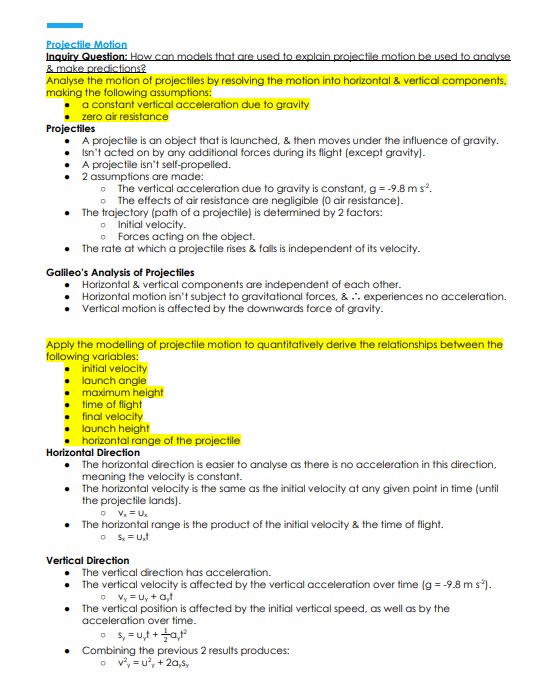HSC Physics Modules
Summary:
The HSC Physics Modules is divided into four parts: Space, Motors and Generators, Waves, and Thermodynamics. Each module covers a range of topics and concepts, including the nature of light and electromagnetic radiation, the operation of motors and generators, wave properties and behavior, and thermodynamic principles and applications. These HSC Physics modules are designed to provide a comprehensive understanding of physics, with an emphasis on the development of problem-solving skills and scientific investigation techniques. The notes for Modules 5-8 provide a detailed explanation of the key concepts and equations covered in each module, along with examples and practice problems to help students consolidate their learning.
Excerpts:
HSC Physics
ADVANCED MECHANISMS
Projectile Motion
Inquiry Question: How can models that are used to explain projectile motion be used to analyze & make predictions?
Analyze the motion of projectiles by resolving the motion into horizontal & vertical components,
making the following assumptions:
● a constant vertical acceleration due to gravity
● zero air resistance
Projectiles
● A projectile is an object that is launched, & then moves under the influence of gravity.
● Isn’t acted on by any additional forces during its flight (except gravity).
● A projectile isn’t self-propelled.
● 2 assumptions are made:
○ The vertical acceleration due to gravity is constant, g = -9.8 m s-2
○ The effects of air resistance are negligible (0 air resistance).
● The trajectory (path of a projectile) is determined by 2 factors:
○ initial velocity.
○ Forces acting on the object.
● The rate at which a projectile rises & falls are independent of its velocity.
Galileo’s Analysis of Projectiles
● Horizontal & vertical components are independent of each other.
● Horizontal motion isn’t subject to gravitational forces, & ∴ experiences no acceleration.
● Vertical motion is affected by the downward force of gravity.
Apply the modeling of projectile motion to quantitatively derive the relationships between the
following variables:
● initial velocity
● launch angle
● maximum height
● time of flight
● final velocity
● launch height
● horizontal range of the projectile


Reviews